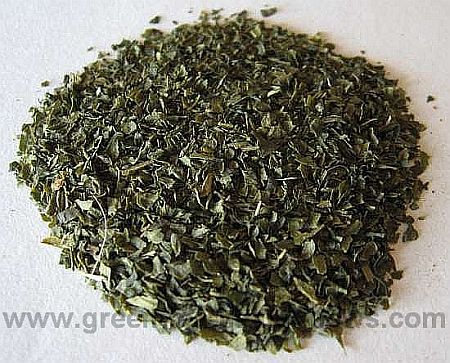Japanese Sencha Tea

What is Japanese sencha tea?
It is a great refreshing drink.
Enjoyed by 150 million people every day, it is smooth and cleans the palate with a hint of sweetness.
This tea is pleasantly brisk, and the fragrance is a subtle grassy-floral blend.
The leaves are large and highly uniform. The color is a rich shiny emerald.
The liquor is a bright lime yellow-green.
When do you drink Japanese sencha tea?
Most people will drink 5 to 10 cups of this tea throughout the day.
This is the tea variety that clears the brain, cleans and normalizes the body, and lets people sort things out.
It's an easy way to take a short break and gain a better perspective on life’s daily problems.
This Japanese green tea works well with foods that are complex and strongly flavored.
It’s a great choice with curry, garlic, and light Mexican foods.
It can be paired with foods like chicken, turkey, fish, and seafood.
Sencha’s unique taste also shines with vegetables, and vegetarian meals like vegetarian pizza.
You can serve it with heavier desserts like cakes, pies, and pastries made of fruit, cheese, and cream.
People who are creative with food prefer sencha with milk chocolate desserts rather than dark chocolate, but that is always a personal decision.
How do you make a cup of Japanese sencha tea?
Use one teaspoon of loose leaf per cup.
Steeping time can vary from one minute to four minutes, and water temperature can vary from 160F to 190F, according to your tastes.
The higher the grade of tea, the lower the water temperature, and the shorter the steeping time.
You can also get several infusions from a higher grade.
As with all green teas, use a high quality spring water.
Never use chlorinated water to make any tea that you drink and never add milk or sugar to high quality green tea.

Buy at AllPosters.com
What is its history?
Buddhist monks brought the first tea seeds to Japan in 805 A.D., but it was when the Zen priest Eisai brought large teagardens to the Uji area near Kyoto that the heart of Japanese green tea was born.
Early tea processing was limited to steaming only.
Japanese sencha tea was not developed until 1738 when a merchant named Soen Nagatani perfected the processing with steaming, hand-rolling, and pan-firing or drying.
Currently, more than 75% of all tea produced in Japan is made into Japanese sencha tea.

Mt. Fuji and Tea...
Buy This at Allposters.com
How is it made today?
Japanese teagardens cultivate the plants side-by-side in very long rows around two feet high and five feet wide.
The plants are left in full sunshine, unlike the shaded matcha and gyokuro.
Beginning in the spring, plucking machines gather the leaves four times a year with 45 day intervals.
The leaves are cleaned, sorted, steamed, dried in a hot air tunnel, then rolled into a needle shape and dried again.
Some of the most prized leaves are reserved for hand plucking and processing.
This loose leaf green will be used only for competition grade senchas.
What is the best Japanese sencha tea?
The highest grades of this tea are generally from the earliest spring pluckings and are hand-crafted. They will have the most uniform leaf presentation, and the tea will have the smoothest, cleanest taste.
The Yame region is known for a needle shaped dried leaf, and Kyushu is known for a comma-shaped dried leaf, similar to the famous Chinese Chun Mee tea, one of the eyebrow teas.
Where is it grown?
The first Japanese green teagardens were in the Uji area, but now it is grown around Tokyo and throughout the southern islands.
Ancient gardens from a thousand years ago near Kyoto are still producing tea every year.
What's Your Favorite Green Tea?
Tell us about that favorite green tea that always puts you in the right mood for a great day!
What Other Visitors Have Said
Click below to see contributions from other visitors to this page...
Jackson's green tea 




These two Jackson's of Piccadilly (TM) teas are vital to the day.
Jackson's green tea with lemon during the day and with mint in the evening.
My …
Simply Sencha 




My friend has just sent me a pack of Simply Sencha from www.tea4life.co.uk and I was very pleasantly surprised.
I knew how good Sencha was meant to be …
sencha green tea and jasmine Not rated yet
A Doctor advised me not to drink too much coffee. So I discovered teabags, and later tea without bags;
Now I prefer Sencha tea and jasmine green tea. …
Sign up here for free subscription to the Green Tea Health Newsletter:
Tell A Friend
Are you a member of a social networking site like Facebook, Google +, or the popular Twitter? If you like my website, share it with your friends and family! I appreciate it also, and thank you in advance.
or email it:
http://www.green-tea-health-news.com/japanese-sencha-tea.html
Did you like this page on japanese sencha tea? Here are more gourmet tea ideas
This page was last updated by Sharon Jones.
New ebook offers
Subscribe to the free e-zine, Green Tea Health News for new ebook offers, link archives, new recipes, helpful products, hot deals, and more.Subscribe now and don't miss a single issue.
This website supports
planting Giant Sequoia trees.Find out more!

